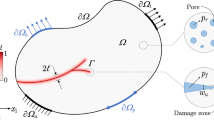Abstract
A regularized variational model of fracture mechanics for masonry-like materials has been recently proposed: this is based upon the competition between bulk-energy release and surface-energy production due to the nucleation and/or progression of cracks, assumed they can open in mode I only. This model is applied here to derive a theory of strength in confined masonry-like materials, where an inhomogeneous state of stress is due to heterogeneous inclusions or boundary constraints. The theory accords the phenomenon of rupture an energetic interpretation. Under tension, opening of mode I fractures at right angle to the axis of loading is clearly energetically favorable; under compression, the solid splits because in doing so the stress is released so to reduce the total energy. Numerical experiments have been performed for prismatic solids under fixed lateral confinement and increasing uniaxial tension or compression up to failure. Representative domains for the strength under biaxial stress are thus deduced.













Similar content being viewed by others
Notes
The two absolute values of \(\overline{u}\) are different because the resistance under traction is expected to be much lower than under compression.
References
Giaquinta M, Giusti E (1985) Researches on the equilibrium of masonry structures. Arch Ration Mech Anal 88:359–392
Heyman J (1966) The stone skeleton. Int J Sol Struct 2:249–256
Di Pasquale S (1992) New trends in the analysis of masonry structures. Meccanica 27:173–184
Wang EZ, Schrive NG (1995) Brittle fracture in compression: mechanisms, models and criteria. Eng Frac Mech 52:1107–1126
Mohr O (1990) Welche Umstaende bedingen die Elastizitaetsgrenze und den Bruch eines Materials?. Zeitschrift des Vereines deutscher Ingenieure 44:l–12
Vardoulakis I, Sulem J (1995) Bifurcation analysis in geomechanics. Blackie Academic and Professional, London
Labuz JF, Bridell JM (1993) Reducing frictional constraint in compression testing through lubrication. Int J Rock Mech Min Sci Geomech Abstr 30:451–455
Jaeger GC, Cook NGW (1976) Fundamentals of rock mechanics. 2nd Ed., Champan and Hall, London
Schulson EM, Gies MC, Lasonde GJ, Nixon WA (1989) The effect of the specimen-platen interface on internal cracking and brittle fracture of ice under compression: high-speed photography. J Glaciol 35:378–382
Santiago SD, Hilsdorf HK (1973) Fracture mechanism of concrete under compressive loads. Cem Concr Res 3:363–388
Blakey FA (1952) Mechanism of fracture of concrete. Nature 170:1120
Slate FO, Hover KC (1984) Microcracking in concrete. In: Fracture mechanics of moncrete: material characterizaton and testing. Martinus Nikhoff, The Hague
Bell JF (1973) The experimental foundations of solid mechanics. Encycl Phys Via/l, Sect. 3.3, Springer, Berlin
Vardoulakis I, Exadaktylos G, Kourkoulis SK (1998) Bending of marble with intrinsic length scales : a gradient theory with surface energy and size effects. J Phys IV 8: Pr8/399–Pr8/406
Horii H, Nemat-Nasser S (1986) Brittle failure in compression: splitting, faulting and brittle-ductile transition. Phil Trans R Soc Lond A319:337–374
Ortiz M (1985) A constitutive theory for the inelastic behavior of concrete. Mech Mater 4:67–93
Vardoulakis J, Labuz J, Papamichos E, Tronvoll J (1998) Continuum fracture mechanics of uniaxial compression on brittle materials. Int J Sol Struct 35:4313–4335
Bhattacharya K, Ortiz M, Ravichandran G (1998) An energy-based model of compressive failure in inhomogeneous brittle solids. J Mech Phys Solids 46: 2171–2181
Freddi F, Royer-Carfagni G (2010) Regularized variational theories of fracture: a unified approach. J Mech Phys Solids 58:1154–1174
Bourdin B, Francfort GA, Marigo JJ (2000) Numerical experiments in revisited brittle fracture. J Mech Phys Solids 48:797–826
Ambrosio L, Tortorelli VM (1990) Approximation of functional depending on jumps by elliptic functionals via \(\Upgamma\)—convergence. Comm Pure Appl Math XLIII:999–1036
Del Piero G (1989) Constitutive equation and compatibility of the external loads for linear elastic masonry-like materials. Meccanica 24:150–162
Bazant Z, Planas ST (1998) Fracture and size-effect in concrete and other Quasi-Brittle materials. CRC press, New York
Kupfer H, Hilsdorf HK, Rüsch H (1969) Behaviour of concrete under biaxial stress. J Am Concr Inst 66:656–666
Del Piero G, Owen DR (1993) Structured deformations of continua. Arch Rat Mech Anal 124:99–155
Kachanov LM (1958) On the rupture-time under creep conditions. Izv Akad Nauk SSSR 8:26–31. (in Russian)
Lancioni G, Royer-Carfagni G (2009) The variational approach to fracture mechanics. A practical applicaton to the French Panthéon in Paris. J Elast 95:1–30
Bangerth W, Hartmann R, Kanschat G deal.II Differential equations analysis library, Technical reference. http://www.dealii.org
Page AW (1981) A biaxial failure criterion for brick masonry in the tension-tension range. Int J Mason Constr 1:26–29
Page AW (1981) The biaxial compressive strength of brick masonry. Proc Inst Civ Eng Part 2 71:893–906
Page AW (1983) The strength of brick masonry under biaxial tension-compression.Int J Mason Constr 3:26–31
Acknowledgments
Partial support of the Italian MIUR (Ministry of Education, University and Research) under the PRIN2008 program is gratefully acknowledged.
Author information
Authors and Affiliations
Corresponding author
Rights and permissions
About this article
Cite this article
Freddi, F., Royer-Carfagni, G. Variational fracture mechanics to model compressive splitting of masonry-like materials. Ann. Solid Struct. Mech. 2, 57–67 (2011). https://doi.org/10.1007/s12356-011-0018-4
Received:
Accepted:
Published:
Issue Date:
DOI: https://doi.org/10.1007/s12356-011-0018-4




